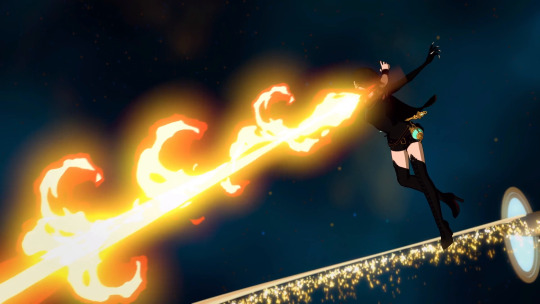#cinder ''anthropomorphic personification of a fianchetto'' fall.
Text
actually no i WILL elaborate re: #and the punchline is: salem’s playing the dragon variation (here)
ok. so. rwby’s chess motif is chiefly there to foreshadow and then articulate the paradigm shift that occurs between salem and cinder in V8; insofar as any other characters are involved in the chess symbolism it is largely in service of clarifying what’s being said about those two. but first we have to talk about
✨chess theory✨
for context. some basics. briefly.
if you’re not a Chess Person you probably have at least a vague idea of what the pieces are, how they move, and their relative value. but that’s as good a place as any to start, so:
a chessboard has numbered ranks (rows) 1-8 and lettered files (columns) a-h. you can notate a specific square this way: a1 is the dark square in the bottom left corner of the board. white’s pieces start on 1, black’s on 8. the queens start on the d file, the kings on e. pieces that start on a,b,c are called the queen’s or the queenside and likewise pieces that start on f,g,h are the king’s or kingside.
from the edge of the board in, the pieces go on in this order: rook -> knight -> bishop. then the eight pawns start in ranks 2 and 7.
pawns (P) can move 1 square forward and capture pieces that are 1 square diagonally in front of them (so a pawn on the light square e4 can move to the dark square e5 if it’s empty, or capture a piece occupying the light squares d5 or f5). from their starting position only they are allowed to advance 2 squares if both are empty. they also have a special and highly situational pawn capture (en passant) that Isn’t Important but i have to mention it because it’s really fucking funny to catch the unwary with. look it up. they cannot move backwards, but if a pawn travels all the way across the board to reach the 8th/1st rank they can be promoted to a piece of the player’s choosing (knight, bishop, rook, or queen)—usually queen but there are certain circumstances where a knight is preferable.
rooks (R) move in straight lines vertically or horizontally across any number of unoccupied squares. if they land on an occupied square the piece is captured. rooks also have a special move they can perform with the king if 1. neither the rook nor king have moved yet, 2. the king is not in check, 3. the king would not move through or into check, and 4. every square between the rook and the knight is empty. this move is called castling and it moves the king two squares in the direction of the rook whilst jumping the rook over the king into the light square adjacent to the king’s new position. so if white castles kingside, the king moves e1 to g1 and the rook moves h1 to f1; if white castles queenside the king moves to c1 and the rook moves a1 to d1.
knights (N) move in an L shape (1 square either horizontally or vertically, then 2 squares at a right angle to the first direction, or 2 then 1), jumping over any pieces in between. if they land on an occupied square the piece is captured; pieces they jump over are not captured.
bishops (B) move in straight lines diagonally across any number of unoccupied squares, capturing a piece if they land on it. both players have a dark square and a light square bishop; bishops can never move onto squares of a different color from their starting square.
queens (Q) can move and capture like a rook or a bishop; so, in a straight line horizontally, vertically, or diagonally across any number of unoccupied squares.
kings (K) can move 1 square in any direction (outside of castling). if an adjacent square is occupied they can capture the piece. the king has the unique restriction that it cannot move into a square where it would be under attack, so if there is a white rook on b3 and the black king is on c2, b2 and c3 are not legal moves.
a piece is attacked when it occupies a square that could be taken by an opposite-color piece; if the king is attacked it is in check and the player must use their turn to get the king out of check (by moving the king, blocking the path of attack with a different piece, or capturing the attacking piece). the goal of chess is to checkmate the opponent by forcing the king into an inescapable check; you do not win chess by capturing the king, you win by trapping the king in a position in which your opponent has no legal moves.
(if the king is not in check but one player has no legal moves, the game is a stalemate and ends in a draw.)
so it’s not about overpowering the enemy… :)
anyway. chess pieces are conventionally given relative valuations (standard is P=1, N=3, B=3, R=5, Q=9) for the purpose of having a loose rule-of-thumb to quickly assess positions during a game. but—and this is the important part—piece valuations are only rough approximations of the actual strength any given piece might have on the board, because how strong or weak a piece might be is contingent on a lot of things. the queen isn’t always the strongest piece on the board; pawns are extremely important in the opening and can be really strong in the endgame. etc
so! chess strategy and tactics! basic ideas:
space—that’s how much of the board you control—is very important. space can be evaluated by counting up how many squares a player currently occupies or has attacked (including empty squares that an opposing piece cannot safely move into because they are in an attack line) on the opposing side of the board.
control of the center—d4,e4,d5,e5, the four squares in the center of the board—is achieved by developing pieces to attack those squares. controlling the center is the goal of the opening because the player with the strongest control over those four squares has the advantage in
initiative, which belongs to whichever player is able to attack in a way that their opponent has no choice but to respond, like putting a king in check or otherwise forcing the opponent to defend rather than develop their own position.
placing one piece on a square from which it can attack a square currently occupied by a friendly piece defends the friendly piece; if the opponent captures a defended piece and the defender captures the captor that’s called an exchange. a piece in a defensive position to more than one other piece, or a piece under more than one attack, is overworked and therefore weak.
the strongest piece on the board at any given time is a piece that: 1. can attack through the center, 2. is defended, 3. is not overworked, 4. is not closed in by friendly pieces, and 5. is able to capture, put the opponent king in check, or defend another piece doing those things.
ok! this:

is the setup for an opening called the sicilian defense, dragon variation. black has just moved the kingside knight’s pawn to g6 and will on the next turn move the kingside bishop to g7, then castle kingside. this is notoriously one of if not the sharpest openings—a risky, aggressive, highly tactical play. if you open with the dragon your intention is to spend the rest of the game attacking and counterattacking; ideally you keep the bishop on g7 and knight on f6 until you can capture with the knight and reveal the bishop’s attack up the long diagonal. in this game the fianchettoed bishop on g7 is THE strongest and most strategically and tactically important piece on the black side, to the point that every major line for white to counter the dragon aims to weaken the bishop.
ok done talking chess theory now
back to rwby:
in the essentials, the chess symbolism is constructed around the metaphorical game between salem (playing black) and ozma (playing white); the white king is the relics and the black king is remnant freed from the brothers, basically. and the black queen—
—isn’t cinder.
the black queen is a virus written by arthur watts which cinder deploys in tandem with the grimm and the white fang to shatter beacon’s defenses and keep ozpin’s guardians pinned down while she captures the fall maiden and then takes down ozpin.
and that’s the dragon. conceptually. cinder is the bishop fianchettoed on g7 biding her time until the black queen, knights, and pawns launch the attack on white’s queenside defenses and open the long diagonal for her to go in for the kill.
the same setup happens at haven except that this time cinder’s chief opponent is raven, who can see what cinder is doing and counters by baiting her into a more vulnerable position with a decoy and then whacking her.
and then it happens again in atlas, twice, first when cinder plants the black queen in ironwood’s office to force the winter maiden into the open and second when she remembers how this play actually works and gets watts and neo to tear open the line for her before she forces checkmate.
ironwood is the white queen, and he believes salem is the black queen—hence them being positioned as such in the V8 opener. he sees the black queen as salem’s calling card; ruby connects it to cinder. but the black queen is watts—his virus, his icon—and salem identifies herself in both 3.12 and 8.1 as the one playing black; beacon was the first move and it’s her game to win. cinder “holds the key to [salem’s] victory” and cinder is “more valuable to [salem] than a pawn,” so much so that salem values her more highly than the notionally higher-value queen.
because salem plays the sicilian defense, dragon variation. and. well,


…cinder’s the dragon.
#cinder ''anthropomorphic personification of a fianchetto'' fall.#cinder ''chess but in an ‘i will fucking immolate you’ way'' fall.
100 notes
·
View notes